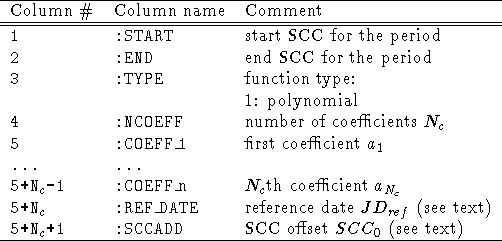




Next: Folding Search - Period
Up: 7.2 The Timing Analysis
Previous: Conversion from Spacecraft Clock
Two commands are available to perform a barycentric correction on
the arrival times. In order to speed up the procedure, a precise
correction (keeping into account the position of the spacecraft as
well) is applied only to the sampling times contained in the orbit
data (sample every second). The correction to the arrival times is
performed then by interpolating the correction computed for
the orbit times.
Thus, in order to apply the barycentric correction to the
photon arrival times,
it is necessary first to run a command to compute the barycentric
correction on the times contained in the orbit file
(CORRECT/ORBIT_DATA).
This command takes in input the orbit data corresponding to the
observation for which the correction is needed, and the equatorial
coordinates of the source which has to be corrected (epoch 2000.0),
and gives in output a table containing the uncorrected and
the corrected orbit times. The output table has four columns,
containing respectively the integer part and the fractional part
of the original times and of the corrected times.
The JPL DE200 ephemeris
[Standish Jr.1982]
are used.
The syntax of the command and the meaning of the command line
parameters is:
CORRECT/ORBIT_DATA output_table alpha delta orbit_table
- output_table is the name of the correction table to
be created.
- alpha is the right ascension (J2000) of the source, in
the format hh,mm,ss.
- delta is the declination (J2000) of the source, in the
format dd,mm,ss.
- orbit_table is the name of the orbit table (in EXSAS
format) related to the current observation.
Then, the data can be corrected with the command
CORRECT/BARYCENTER.
This command takes in input the table in output from
CORRECT/ORBIT_DATA command,
and the equatorial coordinates of the source to be corrected
(epoch 2000.0), and corrects in place the arrival times,
converted to UTC starting from the epoch written
into the descriptor CORR_OFFSET.
The photon arrival times are then expressed in seconds starting
from that epoch.
Notice that this descriptor is not propagated by
any other EXSAS command:
it is thus advisable to apply the barycentric correction only
as the last step before running the timing analysis commands.
The source coordinates are not used for the computation,
but they are requested in order to test the compatibility with
the input table (from CORRECT/ORBIT_DATA).
The correction is computed by means of a linear interpolation between
the corrected orbit times (which have a 1 min sampling time).
The syntax of CORRECT/BARYCENTER and the meaning of its
parameters is:
CORRECT/BARYCENTER data_table corr_table alpha delta
- data_table is the name of the photon event table to be
corrected.
- corr_table is the correction table in output from
CORRECT/ORBIT_DATA.
- alpha is the right ascension (J2000) of the source, in
the format hh,mm,ss.
- delta is the declination (J2000) of the source, in the
format dd,mm,ss.
The correlation between Spacecraft Clock and Universal Time is based on
interpolations of calibration points. The coefficients and time boundaries
for the polynomials are read in from a MIDAS table located in the calibration
area: $exsas_cal:scc_to_utc2.tbl. Each row of the table contains
the information about the interpolation for a specific interval of time.
The structure of the table is:

Table 7.9: Structure of the SCC to UTC calibration table
In the present version, only polynomial functions are used: to get the
UTC from a value of SCC the following formula can be used:






Next: Folding Search - Period
Up: 7.2 The Timing Analysis
Previous: Conversion from Spacecraft Clock
If you have problems/suggestions please send mail to
rosat_svc@mpe-garching.mpg.de


